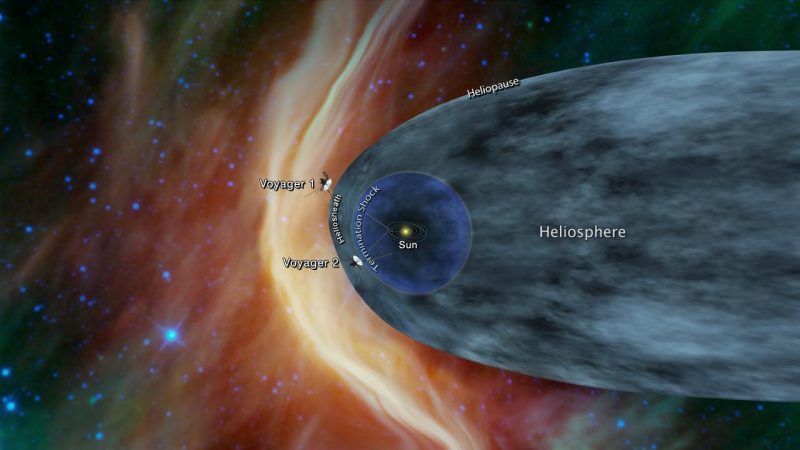
NASA’s Voyager 2 probe, launched in 1977, is on a journey toward interstellar space. NASA says the spacecraft has now detected an increase in cosmic rays – fast-moving particles that originate outside our solar system – which suggests that the spacecraft might be close to crossing into interstellar space.
Voyager 2 is a little less than 11 billion miles (about 17.7 billion km) from Earth, or more than 118 times the distance from Earth to the sun. Since 2007 the probe has been traveling through the outermost layer of the heliosphere – the vast bubble around the sun and the planets dominated by solar material and magnetic fields. Voyager scientists have been watching for the spacecraft to reach the outer boundary of the heliosphere, the beginning of interstellar space as the place where the sun’s constant flow of material and magnetic field stop affecting its surroundings.
Once Voyager 2 exits the heliosphere, it will become the second human-made object, after Voyager 1, to enter interstellar space.
Since late August 2018, the instruments on Voyager 2 have measured about a five percent increase in the rate of cosmic rays hitting the spacecraft compared to early August.
Cosmic rays are fast-moving particles that originate outside the solar system. Some of these cosmic rays are blocked by the heliosphere, so mission planners expect that Voyager 2 will measure an increase in the rate of cosmic rays as it approaches and crosses the boundary of the heliosphere.
In May 2012, Voyager 1 experienced an increase in the rate of cosmic rays similar to what Voyager 2 is now detecting. That was about three months before Voyager 1 crossed the heliopause and entered interstellar space.
However, Voyager team members note that the increase in cosmic rays is not a definitive sign that the probe is about to cross the heliopause. Voyager 2 is in a different location in the heliosheath – the outer region of the heliosphere – than Voyager 1 had been, and possible differences in these locations means Voyager 2 may experience a different exit timeline than Voyager 1.
According to a NASA statement:
The fact that Voyager 2 may be approaching the heliopause six years after Voyager 1 is also relevant, because the heliopause moves inward and outward during the sun’s 11-year activity cycle. Solar activity refers to emissions from the sun, including solar flares and eruptions of material called coronal mass ejections. During the 11-year solar cycle, the sun reaches both a maximum and a minimum level of activity.
Voyager Project Scientist Ed Stone said in a statement:
We’re seeing a change in the environment around Voyager 2, there’s no doubt about that. We’re going to learn a lot in the coming months, but we still don’t know when we’ll reach the heliopause. We’re not there yet — that’s one thing I can say with confidence.
Bottom line: The Voyager 2 spacecraft has detected an increase in cosmic rays, which suggest it’s close to becoming only the 2nd human-made object, after Voyager 1, to enter interstellar space.











